Fun for all the family at Market Bosworth Station Goods Yard. Come along and see;Events of Saturday, 25th August 2018
Splat the rat
Plinko
Hook a duck
Ring toss
Bucket toss
Buzz wire
Ten pin bowling
Basket ball
Boxing
Inflatables
Temporary tattoos
Face painting
Story telling.
Win tickets to collect prizes. Trains running between Shackerstone, Market Bosworth and Shenton all weekend. Get on at Shackerstone or Shenton and receive free entry into the event at Market Bosworth.
I was asked to drive 5542 on the Saturday and was pleased when a text arrived saying that Tracy Tye was firing. I arrived at 7.00 a.m. and found 5542 in the shed with the remains of a warming fire still glowing red and almost 20 pounds on the clock. Tracy arrived just after me so we had almost four hours before the first service. A previous mechanical failure had put the back damper out of service until repairs could be carried out so we contented ourselves with using just the front damper to control 'primary air'.
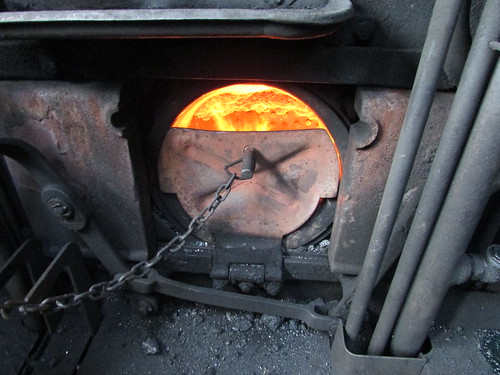
5542 Firehole with Flap plate up.
I left Tracy with the fire whilst I plodded my way through the daily 'exam' and 'oiling round'. Although the '55XX' has outside cylinders, the Link Motion to drive the valves and four of the oil boxes feeding coupled axleboxes are between the frames. The picture below shows me sitting on the leading coupled axle facing backwards underneath the boiler, having climbed up from the inspection pit. I probably look happier than I felt.
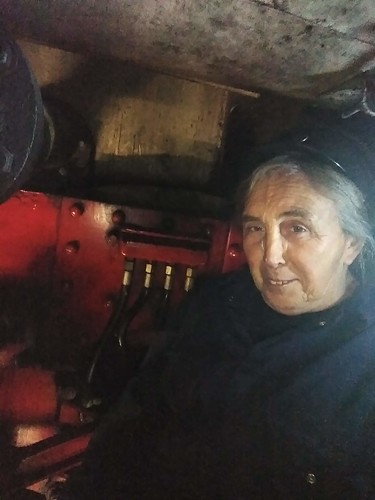
Battlefield Line 2018: Oiling 5524
Oiling and 'daily exam' got a lot easier when designers started to make locomotives with two outside cylinders and outside motion (usually, not invariably, Walschaert's motion). This lesson seemed to be learned very late in the United Kingdom. I admit that many overseas countries had a more generous loading gauge than us, allowing them to use larger outside cylinders than possible here. And I agree that, within the confines of our loading gauge, very powerful locomotives may need a third or fourth cylinder to be able to generate that power (then transferring the problem to the difficulty of making a boiler which can generate enough steam to feed those cylinders without itself fouling the loading gauge). The contortions necessary to complete oiling on some locomotives certainly favour younger people yet, in the 'old days', footplatemen could be quite old before they attained the seniority and experience to be given, say, a 3-cylinder 'Royal Scot' or 4-cylinder 'Castle' to prepare. According to the Wikipedia article here, the Ancient Greeks first looked into what we now call 'Ergonomics' or 'Human Factors' but it was the American engineer Frederick Winslow Taylor (1856-1915) who first applied the ideas to increasing the productivity of workers in the industrial age.
In the early part of the day, we had some difficulties with steaming and lost a little time. The mantra is "Get it hot and keep it hot" but that's hard to achieve on the sort of diagram we were undertaking. On a long distance express, once the engine is hot, it can be kept that way by adjusting the firing rate to match the demand for steam. The fireman may be able to set an injector fine enough to leave it running and maintain the boiler water level. But our booked timings were as below:-
| Shackerstone Dep | 11.00 | 12.15 | 13.45 | 15.00 | 16.15 |
| Market Bosworth Dep | 11.12 | 12.27 | 13.57 | 15.12 | 16.27 |
| Shenton Arr | 11.20 | 12.35 | 14.05 | 15.20 | 16.35 |
| Shenton Dep | 11.35 | 12.50 | 14.20 | 15.35 | 16.50 |
| Market Bosworth Dep | 11.45 | 13.00 | 14.30 | 15.45 | 17.00 |
| Shackerstone Arr | 11.55 | 13.10 | 14.40 | 15.55 | 17.10 |
Looking at the timings for the first trip (later trips have similar allowances), the engine uses steam for no more than about ten minutes before there's a brief stop at Market Bosworth. Then steam is consumed for less than ten minutes before arriving at Shenton. That's an oversimplification. Leaving Shackerstone, there's a succession of different 'slacks' (speed restrictions) until the top of the bank, then Line Speed (25 m.p.h.) is interrupted by a very short distance with a temporary restriction at 10 m.p.h., then there's a succession of different 'slacks' into and out of Market Bosworth before Line Speed is authorised until the run-in to Shenton where the restriction is 5 m.p.h. Of course, the same speed restrictions apply on the return journey but, with the gradients now reversed, the effect on driving method is different.
Because of the variations in allowable speed, the driver frequently adjusts the regulator (the large handle which lets steam into the cylinders from the boiler) between 'Drifting' (essentially closed but with sufficient steam to ensure adequate lubrication to the pistons and valves) and various 'Open' settings. Alternately, the driver can choose to adjusts the 'Cut-off' (altering the percentage of piston travel for which live steam is admitted to the cylinders). Cut-off is adjusted on the reverser which is a lever (or 'Pole') reverser on 5542.
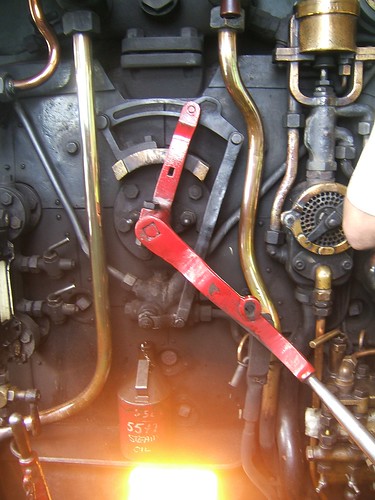
5542: The Regulator Handle in the 'Drifting' position.
So the demand for steam is rapidly changing, requiring close co-operation between driver and fireman to avoid either having insufficient steam to work the train to time or too much resulting in discharge of steam from the safety valves (wasting coal, water and fireman's shovelling efforts). Although the rate of steam generation can be altered by altering the rate at which fuel is added, by control of the dampers ('primary air'), by adjustment of the firedoors ('secondary air') and by adjustment of the artificial draught using the Blower, change does not occur instantly. There's another, rather cryptic, mantra: "Driver's steam - Fireman's steam". That means, when the regulator is open, the fireman should be producing steam at a sufficient rate to keep the driver happy ("Driver's steam") but as soon as the regulator is closed or set to drifting, the steam still being produced is at the disposal of the fireman ("Fireman's steam"). This gives the fireman the chance to put on an injector, replenishing boiler water and the cooling effect tends to preventing wastage of steam from the safety valves.
There are a number of posts in this blog which discuss various aspects of the footplatemens' art. Most of these can be found in the series of articles labelled 'MIC' which are briefly listed in an index here.
On arrival at Shenton, the fireman is then preoccupied with uncoupling the locomotive, working the hand points to let 5542 from the headshunt onto the run-round and keeping a lookout as the locomotive runs the length of the run round, crosses back onto the running line and sets back onto the train.
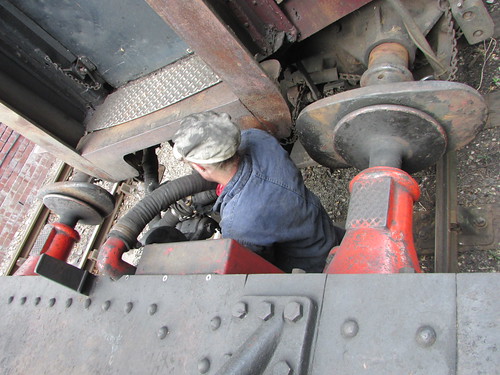
Battlefield Line: Family Fun Weekend August 2018: Tracy uncoupling 5542 from our train.
Finally, the fireman has to couple the locomotive back onto the train. Just 15 minutes is allowed for all these activities, for which I've given only a simplified outline. I've not fully described what's involved in uncoupling and coupling, with heavy screw couplings to manipulate off and onto drawhooks, vacuum hoses to be wrestled apart and connected-up and, in the steam heating season, steam heating hoses to be dealt with. There's a more detailed description of attaching a locomotive to passenger coaches in the post here and more information about screw couplings in the post The Role of the Shunter (2).
On days when a third person is rostered on the footplate (usually a Cleaner gaining practical experience), the workload can be shared but, on the day being described, there was only Tracy and the writer on the footplate: all other available 'bodies' were at Market Bosworth helping with the 'Family Fun Weekend'.
Each time the train returns to Shackerstone, the workload is even worse. Once again, the fireman is preoccupied with uncoupling the locomotive, working the hand points to let 5542 cross to the other platform road and keeping a lookout as the locomotive runs through the station and crosses onto the running line and then sets back towards it train. But, before attaching to the train for the next run, the locomotive water supply is normally replenished at the water column just south of platform 2, as described in the section 'Water Supply' in the post 5542 at the Battlefield Line.
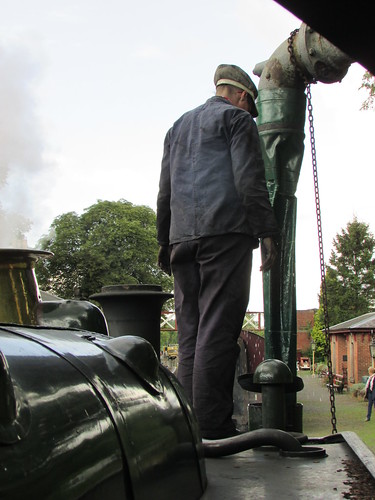
Battlefield Line: Family Fun Weekend August 2018: Watering at Shackerstone. The safety valves are 'sizzling' in traditional Great Western fashion.
Twenty minutes are generally allowed for running round and taking water at Shackerstone. However, in a timetable innovation introduced, I think, this year in between the second and third trains, there's a luxurious 35 minutes allowed for running round and watering, which gave us a chance to depart 'Right Time'.
The fireman is always trying to anticipate the effect of adding fuel because, as stated above, changes in the rate of steam generation do not occur instantly. This is particularly the case when using coals with low volatile content, like the opencast 'Welsh' we were using (which I talked about in the section 'Coal Supply' in the post 5542 at the Battlefield Line).
Both Tracey and I quickly became dirty from the coal dust flying around, although Tracy frequently used the coal watering hose ('pep pipe') in an attempt to lay the dust. One elderly group at Shenton seated outside the Buffet burst out laughing at my appearance - I certainly did look like a refugee from the 'Black and White Minstrels'. A couple of lady passengers at Shackerstone commented (favourably) that we were fielding an all-lady crew. One man, noting the difference in our ages, asked if we were Mother and Daughter. Any parent would be proud to have the independent and determined Tracy as a daughter but I admitted that we were not related.
The weather was hot all day apart from two short, sharp periods of rain. We were gratified at the number of passengers, and we were frequently delayed at Market Bosworth, the base for the entertainments, because of the number of passengers joining and leaving the train. Dave N. was the train Guard and his help in changing the loco lamps at each end of the line and taking water at Shackerstone was particularly welcome.
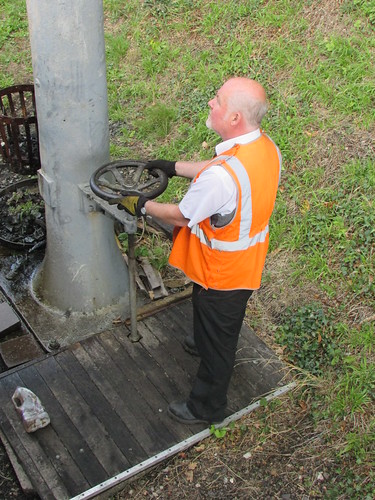
Battlefield Line: Family Fun Weekend August 2018. The Guard, Dave N. assisting with taking water.
Tracy and I completed our shift tired, dirty but pleased the day had been a commercial success. The following day (Sunday) suffered indifferent weather, depressing visitor numbers, but on Bank Holiday Monday, the weather improved and large numbers of visitors arrived to complete an excellent event.
Related posts on this website
To see all my posts about the Battlefield Line, select Label 'Battlefield Line' or click here.
My photograph albums
Where necessary, clicking on an image above will display an 'uncropped' view or, alternately, pictures may be selected, viewed or downloaded, in various sizes, from the albums listed:-
5542 GWR Locomotive
Battlefield Line, 2017-2018
All my Battlefield Line albums
